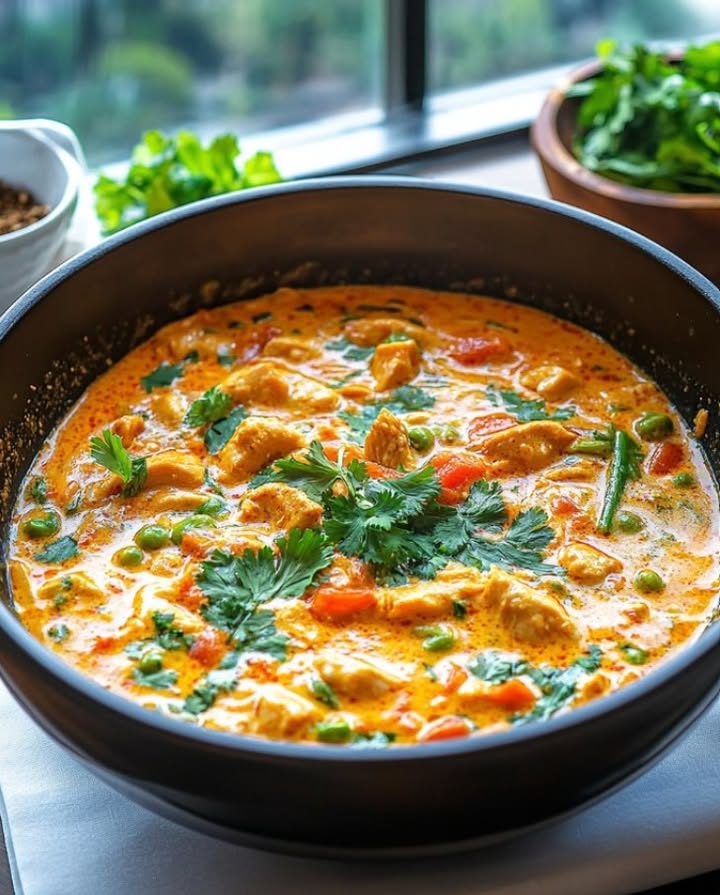
Why Thai Coconut Curry is My Go-To Comfort Food
There’s something magical about the creamy richness of coconut milk paired with bold, spicy curry flavors. I discovered this dish during a trip to Thailand years ago, and it has been my ultimate comfort food ever since. The first time I made it at home, my family couldn’t stop raving about how vibrant and satisfying it was. It’s not just a meal—it’s an experience that warms your soul and fills your kitchen with irresistible aromas. If you’re looking for a recipe that’s easy to make yet feels like a restaurant-quality dish, this Thai Coconut Curry is perfect for you.
The Story Behind This Creamy Delight
Thai cuisine is famous for balancing sweet, salty, sour, and spicy flavors, and this dish is no exception. Traditionally, Thai curries are made using fresh curry pastes blended from herbs and spices. While red curry paste is the star here, modern versions often simplify the process by using store-bought pastes. I remember trying to grind my own paste once—it took hours, but the results were worth it! That said, don’t worry if you’re short on time; today’s recipe uses ready-made ingredients without compromising flavor.
Why You’ll Love This Recipe
This Thai Coconut Curry is packed with flavor, yet surprisingly simple to prepare. The combination of tender chicken, creamy coconut milk, and fragrant spices creates a harmony of tastes that’s hard to resist. Plus, it’s versatile—you can tweak the spice level or add veggies based on your preferences. Whether you’re cooking for yourself or hosting friends, this dish will impress everyone while keeping your stress levels low.
Perfect Occasions to Prepare This Dish
This curry works wonders for weeknight dinners when you need something quick yet impressive. It’s also a crowd-pleaser for casual get-togethers or potlucks. I’ve served it countless times during holiday gatherings, pairing it with fluffy jasmine rice or warm naan bread. Even picky eaters love it because the mild sweetness of coconut milk balances out the heat from the curry paste.
Ingredients List
- 2–3 tablespoons coconut oil or olive oil
- 1 medium/large yellow onion, finely chopped
- 450g boneless, skinless chicken breast, cut into bite-sized pieces
- 3 garlic cloves, minced or pressed
- 2–3 teaspoons ground ginger or 1 tablespoon fresh ginger, finely grated
- 2 teaspoons ground coriander
- 1 can (400ml) full-fat coconut milk (or light, if preferred)
- 1 cup shredded carrots
- 1–3 tablespoons Thai red curry paste (adjust to taste)
- 1 teaspoon salt (or to taste)
- ½ teaspoon freshly ground black pepper
- 3 cups fresh spinach leaves
- 1 tablespoon lime juice
- 1–2 tablespoons brown sugar (optional, to taste)
- ¼ cup chopped fresh cilantro or basil for garnish
- Rice, quinoa, or naan bread for serving (optional)
Substitution Options
If you don’t have all the ingredients handy, no worries! Swap coconut oil with any neutral oil like vegetable or sunflower oil. Chicken can be replaced with tofu or shrimp for a vegetarian or seafood twist. Fresh spinach can be substituted with kale or Swiss chard. For those who prefer less spice, use green curry paste instead of red, or reduce the amount used. And if you’re out of brown sugar, honey or maple syrup work just as well.
Step 1: Sautéing the Aromatics
Start by heating your oil in a large skillet over medium-high heat. Add the onions and let them soften for about 5 minutes, stirring occasionally. The onions should turn translucent and slightly golden, releasing their natural sweetness. This step sets the foundation for the dish, so take your time. Pro tip: Don’t rush the onions—they’re key to building depth of flavor.
Step 2: Cooking the Chicken
Once the onions are ready, toss in the chicken pieces. Cook them for about 5 minutes, flipping frequently to ensure even browning. You want the chicken to develop a nice golden crust while staying juicy inside. Imagine the sizzle and aroma filling your kitchen—this is where things start getting exciting!
Step 3: Adding Spices and Garlic
Next, stir in the garlic, ginger, and coriander. Let these fragrant spices cook for about a minute until they release their aroma. Be careful not to burn them, as spices can turn bitter quickly. This step transforms the dish, layering complex flavors that make Thai Coconut Curry unforgettable.
Step 4: Simmering the Sauce
Pour in the coconut milk, followed by the carrots, curry paste, salt, and pepper. Stir everything together and bring the mixture to a gentle simmer. Lower the heat and let it cook for 5 minutes, allowing the sauce to thicken slightly. Watch as the vibrant orange hue of the curry comes alive—it’s almost too pretty to eat!
Step 5: Finishing Touches
Add the spinach and lime juice, stirring until the greens wilt. Taste and adjust seasoning, adding brown sugar if desired. Garnish with fresh cilantro or basil before serving. Chef’s tip: A splash of fish sauce adds an umami kick that elevates the dish even further.
Timing Breakdown
Preparation takes about 10 minutes, mainly chopping veggies and measuring spices. Cooking time is around 20 minutes, making this a speedy yet satisfying meal. Total time? Just 30 minutes from start to finish—a lifesaver on busy evenings.
Chef’s Secret
For extra creaminess, blend a small portion of the finished curry in a blender or food processor, then mix it back in. This trick gives the sauce a velvety texture without needing heavy cream.
An Interesting Fact About Thai Curries
Did you know that Thai curries were originally made with local ingredients found in different regions of Thailand? Coastal areas favored seafood-based curries, while inland regions leaned toward meat and vegetables. Today, we enjoy a fusion of these traditions, bringing global flavors straight to our kitchens.
Necessary Equipment
You’ll need a large skillet or frying pan, a wooden spoon or spatula, a sharp knife for chopping, and measuring spoons. Optional tools include a blender for smoothing the sauce and a grater for fresh ginger.
Storage Tips
This Thai Coconut Curry stores beautifully in the fridge. Transfer leftovers to an airtight container and refrigerate for up to a week. Reheat gently on the stovetop or microwave, adding a splash of water or coconut milk to loosen the sauce.
If freezing, divide the curry into individual portions for easy reheating. It keeps well for up to three months. Thaw overnight in the fridge before reheating.
Avoid storing the curry with rice or bread, as these absorb moisture and become soggy. Serve them fresh alongside the reheated curry for best results.
Tips and Advice
To enhance the dish, toast whole spices like cumin or coriander seeds before grinding them. Use freshly squeezed lime juice for brighter flavor. Always taste as you go—adjustments are easier earlier than later.
Presentation Ideas
- Serve in colorful bowls with a sprinkle of cilantro and lime wedges.
- Garnish with toasted coconut flakes for added texture.
- Pair with steamed jasmine rice shaped into small mounds for visual appeal.
Healthier Alternatives
1. Low-Carb Version: Replace rice with cauliflower rice.
2. Vegan Twist: Use tofu or chickpeas instead of chicken.
3. Gluten-Free Option: Ensure your curry paste is gluten-free.
4. Lighter Sauce: Opt for light coconut milk.
5. Extra Veggies: Add zucchini, bell peppers, or broccoli.
6. Spicy Kick: Increase curry paste or add chili flakes.
Mistake 1: Overpowering the Curry Paste
Using too much curry paste can overwhelm the dish. Start with 1 tablespoon and adjust gradually. Remember, you can always add more, but you can’t take it away.
Mistake 2: Skipping the Browning Step
Browning the chicken adds flavor and texture. Rushing this step leads to bland, soggy results. Patience pays off here!
Mistake 3: Neglecting Seasoning Adjustments
Don’t skip tasting and tweaking the seasoning. Balancing salt, sweetness, and acidity is crucial for a well-rounded dish.
Mistake 4: Overcooking Spinach
Spinach wilts quickly, so add it last. Overcooking turns it mushy and dulls its vibrant green color.
Mistake 5: Using Old Spices
Fresh spices make a world of difference. Check expiration dates and replace old ones for maximum flavor impact.
FAQ: Can I Make This Dish Ahead?
Absolutely! Preparing Thai Coconut Curry ahead lets the flavors meld, enhancing its taste. Store it in the fridge and reheat gently before serving.
FAQ: What Type of Curry Paste Should I Buy?
Look for authentic Thai brands like Mae Ploy or Maesri. They offer bold, authentic flavors compared to generic options.
FAQ: Is This Dish Kid-Friendly?
Yes! Adjust the spice level by reducing curry paste or skipping it entirely. Kids love the creamy coconut base.
FAQ: Can I Use Frozen Vegetables?
Definitely. Frozen peas, corn, or carrots work great. Just add them towards the end to prevent overcooking.
FAQ: How Do I Know When the Sauce Is Ready?
The sauce thickens slightly after simmering for 5 minutes. It should coat the back of a spoon lightly.
FAQ: Can I Double the Recipe?
Of course! Simply double all ingredients and use a larger pot. Perfect for meal prep or feeding a crowd.
FAQ: Why Does My Curry Taste Bland?
Likely missing acidity or sweetness. Add a squeeze of lime juice or a pinch of sugar to balance the flavors.
FAQ: Can I Substitute Fish Sauce?
Yes, soy sauce or tamari works as a substitute, though fish sauce offers a unique umami flavor.
FAQ: What Rice Works Best?
Jasmine rice complements the dish beautifully due to its floral aroma. Basmati or brown rice are good alternatives.
FAQ: Can I Freeze Leftovers?
Yes, freeze in portions for up to three months. Thaw and reheat for a quick future meal.
This Thai Coconut Curry has become a staple in my household, and I hope it becomes one in yours too. With its rich flavors, versatility, and ease of preparation, it’s a dish that brings joy to every table. Happy cooking!

Thai Coconut Curry
Ingredients
Equipment
Method
- Heat your oil in a large skillet over medium-high heat and add the onions; sauté for about 5 minutes until translucent and slightly golden.
- Toss in the chicken pieces and cook for about 5 minutes until they develop a golden crust.
- Stir in the garlic, ginger, and coriander; cook for about 1 minute until fragrant.
- Pour in the coconut milk, followed by carrots, curry paste, salt, and pepper; mix and bring to a gentle simmer for 5 minutes.
- Add the spinach and lime juice, stirring until the spinach wilts; taste and adjust seasoning, then garnish with cilantro or basil.
